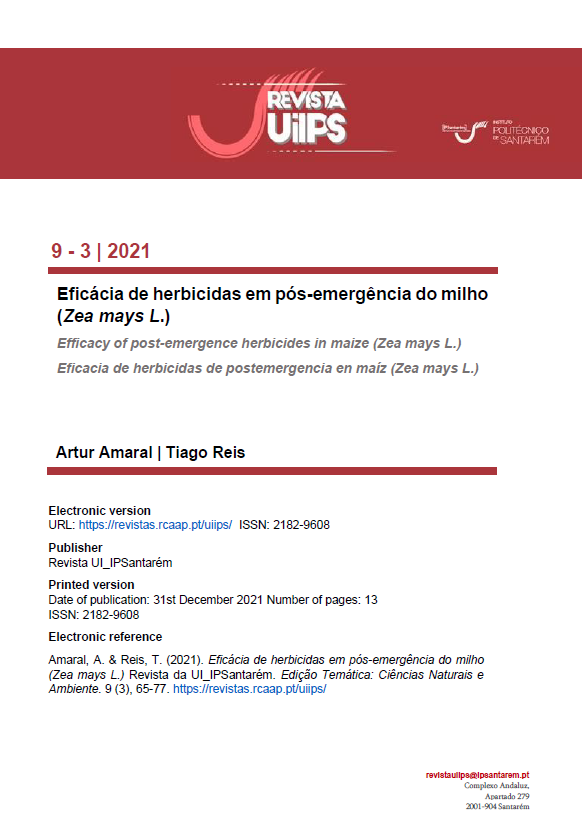Eficácia de herbicidas em pós-emergência do milho (Zea mays L.)
DOI:
https://doi.org/10.25746/ruiips.v9.i3.26203Palavras-chave:
controlo de infestantes, época de aplicação, herbicidas, produtividade, Zea mays L.Resumo
O milho é a cultura arvense com maior superfície cultivada em Portugal. O controlo eficaz das infestantes constitui um dos principais fatores para o seu sucesso. Instalou-se um ensaio em 12 parcelas de 18m2, aleatórias (Santarém) com o objetivo de avaliar a eficácia de três substância ativas em pós-emergência (Dicamba, Mesotriona e Piridato - DMP) conjugada com e sem aplicação “Humigel B” (HB) face a uma testemunha (T) sem qualquer aplicação. Determinou-se a biomassa das infestantes e plantas, os componentes do rendimento e a produtividade. A produtividade foi superior em DMP (15 235 kg/ha) e DMP+HB (15 893 kg/ha) em relação à T. O não controlo das infestantes (T) afetou a produtividade em cerca de 31%. Não se registaram diferenças de produtividade entre DMP e DMP+HB. O número de grãos por espiga foi afetado, mas não o peso de mil grãos, embora este tenha sido ligeiramente inferior na T. O peso seco das plantas em T foi significativamente inferior aos tratamentos com aplicação de herbicida.

Downloads
Publicado
Como Citar
Edição
Secção
Licença

Este trabalho encontra-se publicado com a Licença Internacional Creative Commons Atribuição-NãoComercial-SemDerivações 4.0.
Autores que publicam nesta revista concordam com os seguintes termos:
- Autores conservam os direitos de autor e concedem à revista o direito de primeira publicação, com o artigo simultaneamente licenciado sob a Licença Creative Commons Attribution que permite a partilha do trabalho com reconhecimento da autoria e publicação inicial nesta revista.
- Autores têm autorização para assumir contratos adicionais separadamente, para distribuição não-exclusiva da versão do artigo publicado nesta revista (ex.: publicar em repositório institucional ou como capítulo de livro), com reconhecimento de autoria e publicação inicial nesta revista.
- Autores têm permissão e são estimulados a publicar e distribuir o seu trabalho online (ex.: em repositórios institucionais ou na sua página pessoal) a qualquer ponto antes ou durante o processo editorial, já que isso pode gerar alterações produtivas, bem como aumentar o impacto e a citação do trabalho publicado.


